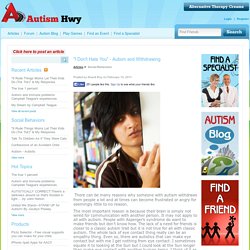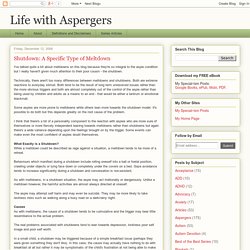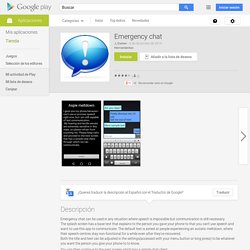

Ask an Autistic - What are Autistic Shutdowns? [work in progress] - signs of a shutdown in autistic people. Informative Friendship Network. There can be many reasons why someone with autism withdraws from people a lot and at times can become frustrated or angry for seemingly little to no reason.

The most important reason is because their brain is simply not wired for communication with another person. It may not apply to all with autism. People with Asperger’s syndrome do want to make friends but don’t know how. The lack of a need for friends is closer to a classic autism trait but it is not true for all with classic autism. The whole lack of eye contact thing really can be an empathy thing. There are two different types of personalities: extroversion and introversion. What I want to talk about now is change. I rarely have a huge Earth shattering meltdown because I can recognise when one is coming on and I can make myself avoid it from happening. Life with Aspergers: Shutdown: A Specific Type of Meltdown. I've talked quite a bit about meltdowns on this blog because they're so integral to the aspie condition but I really haven't given much attention to their poor cousin - the shutdown.

Technically, there aren't too many differences between meltdowns and shutdowns. Both are extreme reactions to everyday stimuli. Both tend to be the result of long term unresolved issues rather than the more obvious triggers and both are almost completely out of the control of the aspie rather than being used by children and adults as a means to an end - that would be either a tantrum or emotional blackmail. Some aspies are more prone to meltdowns while others lean more towards the shutdown model. It's possible to do both but this depends greatly on the root cause of the problem. What Exactly is a Shutdown? Behaviours which manifest during a shutdown include rolling oneself into a ball or foetal position, crawling under objects or lying face down or completely under the covers on a bed. Aspie Shutdown by Jerrekedb on DeviantArt.
Emergency chat. Minute provides a simple way to track your daily usage of your installed apps (such as Facebook, Whatsapp, Instagram, Snapchat), including the native Android apps (such as Messaging).

If you wonder how much time you spend on apps of your phone or your tablet, or if you are simply interested in tracking your daily activity with all your apps, then Minute can surely help. By implementing a simple and efficient yet elegant data visualization module, Minute helps you check and track all of your usage data in a single glance. You can keep track of how much time you spend on each of your apps individually. You can also compare your usage of different apps over several days. Using the app is very simple. The data collection process starts once you launch the app for the first time. . * Note: Minute does not use your Internet.
Keywords: App Usage Tracking, Data visualization, Light Weight App Tracking, Android App Usage Data. Neurowonderful — Is shutting down completely an autistic trait?... Where I Go When I Shutdown. This is loosely related to last week’s post on flat affect.

When I look blank or checked out, sometimes it’s because I’ve withdrawn or shut down. “You disappeared.” When my husband said this to me, we were sitting in a restaurant waiting for lunch to arrive. It was the tail end of a great weekend at the beach and I was off in my own world. Withdrawal. For me, withdrawal feels more accurate. Sitting in the restaurant, I felt the telltale signs of withdrawal creeping up on me. The second sign–the one that makes it clear I’m not just overtired–is the sensation of moving through a long tunnel. Once I’ve drifted far enough into the tunnel, I’m quite content to sit and stare off into space, detached from everything that’s happening around me. Cumulative Stress My withdrawals are almost always triggered by cumulative stress. Lately I’ve been thinking a lot about why I frequently catch people staring at me, often repeatedly over the course of a meal or a train ride. Going Offline Resurfacing Related.